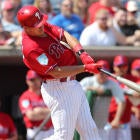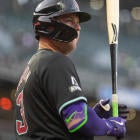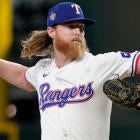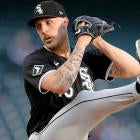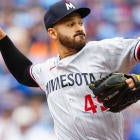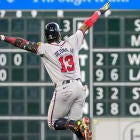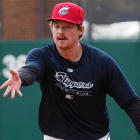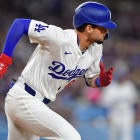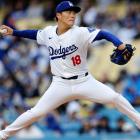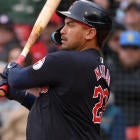For more Fantasy baseball insights, and to keep up with all the latest news, roster trends, and more throughout the season, subscribe to Fantasy Baseball Today now on iTunes, Stitcher, or Spotify. You can find us on YouTube now, with full episodes and clips available every Monday through Friday.
As a big proponent of not getting trapped into one strategy, I may seem like a strange choice to write an article about the perfect draft. It's true that I'm not going to force a particular strategy, and I'm more than happy to let the draft come to me. But that doesn't mean I don't got into a draft with a plan.
Far from it.
The truth is I generally go into a draft with two or three plans. I've got a backup and a backup to the backup. I'm not going to get cornered by the rest of the league and often change plans mid-draft. Everyone should be prepared to do the same. But we're not here today to talk about fall-back plans. We're here for the perfect draft. The one you walk away from legitimately believing you're going to dominate the competition. Yes, you'll need to be active on the waiver wire, you'll have to make tough start/sit decisions, you'll work the phones for trades. But if you execute these plans, you'll set yourself up for a season of domination.
Points
All of these strategies will be contingent on draft position to a certain degree. But in a points league I really want to get at least one of my top eight starting pitchers, and I'm not going to hesitate to take two with my first three picks. For that reason, a pick in the top-three in this format is desirable. If I can start my draft with Mookie Betts, Mike Trout or Jose Ramirez and then grab two of the Blake Snell, Aaron Nola, Gerrit Cole range of starting pitcher, I feel like I've started about as well as I can start a draft.
In the fourth round I'm hoping J.T. Realmuto is still there, but I'll settle for Gary Sanchez. The catcher position is truly dreadful and the top two both have the potential to be top-30 hitters regardless of position. In Points leagues most hitter positions are deep, so I'd like to grab a true advantage at one of the only thin positions. I'd follow that up by taking one of the first basemen left, whether it's Matt Carpenter, Joey Votto or Jose Abreu.
I'm not a huge fan of the pitcher values or infield values in Rounds 6-8. The one exception being Travis Shaw, who has second base eligibility and may just lead the position in home runs and RBI. In addition, it's not unusual for me to fill up my outfield with picks like Mitch Haniger or Michael Brantley and Eloy Jimenez.
I've generally taken one closer by the time we get to Round 9, but I don't care which of my top eight it is. Brad Hand seems to fall more often than the other seven, and I'm thrilled when I can get him in the ninth round. Hand has been elite each of the past two years, has no competition for saves and now pitches for a team we expect to win 90 games.
Round 10, for me, is where starting pitcher starts to get appetizing again. Shane Bieber's ADP has climbed to 114 overall in CBS drafts and I'm thrilled take him there. I might take three starters in a row at this stage of the draft, including pitchers like Yu Darvish, Kenta Maeda (SPARP!), Luis Castillo, Jon Gray and Nick Pivetta.
The pitcher run stops in Round 13, when I take my most drafted shortstop, Paul DeJong. I wouldn't mind taking DeJong in Round 10, but there doesn't ever seem to be anyone fighting over him. In an ideal situation this leaves me with just one infield spot left to fill, second or third base, and a utility. My pitching staff is also near completion, with the need for one more starter or reliever, depending on if I took Maeda earlier. A few notes about the next few rounds:
- If I had the third pick and missed Betts/Trout, this is where I'd be looking for Jesse WInker or Mallex Smith to fill out my outfield.
- Cesar Hernandez is generally the second baseman I settle for if I don't have one yet. At third base, it would be Rafael Devers or Mike Moustakas.
- I don't rush into my last reliever. I'm happy with Jordan Hicks or a SPARP like Julio Urias or Matt Strahm. The presence of SPARPs makes it easy for every team to fill their second closer spot.
- If I need one more starting pitcher, I'm doing my best to get Jesus Luzardo. I believe the kid is a future star, and he'll either be in the rotation in April or knocking on the door.
- I'd like for my utility to be an outfielder or a player with multi-position eligibility. Jake Bauers fits both and is basically free.
The final rounds of a points league draft are generally pitcher-heavy, and I endorse that. But I don't think it's quite as simple as just going down the pitcher rankings. I want one SPARP who I believe could also be startable in an SP slot. I want a couple of upside pitchers (Touki Toussaint, Luke Weaver), and I'd like at least one innings eater, probably a bounceback candidate like Marcus Stroman.
That doesn't leave a lot of room for bench hitters, which is fine because the waiver wire will be full of them. But I would like to back up my weakest positions. If I settled for Moustakas as my third basemen, I'd spend one of my last picks on Jung Ho Kang. If Hernandez is my second baseman, I'd take some upside with Luis Urias.
Rotisserie
There's definitely some debate here at CBS in the difference between Points and Roto. On one hand, the rosters in Roto are much deeper, replacement cost is much lower. That would tend to point you towards safer players in Roto, because whiffing can really cost you.
The flip side of the argument is the process of actually winning the league. In a Points league you need to be in the top six teams at the end of the regular season, then you need three wins in a row to be champion. In Rotisserie, you have to beat 11 other teams over the entire season. Sixth-place four months into the year just means your season is over. For that reason, I tend to shoot for the moon more often in Rotisserie leagues.
There's still a value to aces in this format, but it's not quite the same priority for me. I'd like to get one of my top-eight starters and that can generally be accomplished by taking one in the first three rounds. After that I'm content to focus on bats and closers, because both are more scarce in this format.
The ideal start for me comes with pick four through six. I'm thrilled to land Jose Altuve or Trea Turner in this range, giving me a good start on the two categories I worry the most about, steals and batting average. With that draft slot, there's not much value at pitcher in Round 2, so I generally gravitate towards Freddie Freeman. Freeman probably isn't an elite power option, but he's good everywhere and in combination with the first-round pick makes average less of a concern moving forward.
Rounds 3 and 4 look very similar for me in points and Rotisserie. I want one of those aces and one of the top two catchers. Round 5 is where things change a little bit, because I already have Freddie Freeman and I'm not sure I have enough steals. That makes Lorenzo Cain an easy pick. Cain should hit close to .300 and be a great secondary source of steals.
Depending on the league, Round 6 might be where I start to look for saves, but it's more likely I wait until Round 7. One thing that I'd definitely like to accomplish is to get two closers before Round 9. Hand is still a common target here, but if closers really fly off the board I'll boost Corey Knebel into this discussion as well. The injury to Jeremy Jeffress should provide Knebel with more save opportunities early in the year.
The hitters I'm looking at in Rounds 6-10 are Shaw, Joey Gallo and Eloy Jimenez. I'd prefer Gallo be one of those hitters if I started with Turner, Freeman, Realmuto and Cain because I'm short on home runs. I might lean more toward Jimenez if I had Sanchez instead of Realmuto. Jimenez does make it necessary to draft a sixth outfielder, since he won't be up for opening day. Of course, we're talking perfect draft, so let's take both.
In the early double-digit rounds, I'm definitely looking at the same upside pitchers, just realize you can probably start in Round 11 or 12 instead of Round 10. This is also a range where I'm willing to take my second catcher, which definitely provides separation from the competition. Current ADP shows Willson Contreras and Buster Posey in the double digit rounds. In some drafts it will be Wilson Ramos or Yasmani Grandal falling instead. I'm fine with any of them starting in Round 10. If catchers go early, Danny Jansen will be there in Round 14 and has top-five upside at the position.
After Round 14 I've filled both catchers, three of four infield slots, and I have three outfielders. I have four starting pitchers and two closers. This is a good time to take Winker again and then pick Luzardo to give the pitching staff more upside. I also want to get a third closer, and Alex Colome seems to be one of the last sure closers to be taken with an ADP of 210.
Of course, one of the best thing about Rotisserie leagues is that you don't have to just fill positions, you have to fill categories. I feel great about my pitching staff and only have one spot left to fill. On offense you may feel like you need a little power, maybe a little speed. Domingo Santana has an ADP of 215 overall and could give you both without hurting too much in batting average. Another good option in this range is Gregory Polanco, but not if you've drafted Jimenez earlier. I don't want to spend too much on players I may not see until May.
Multi-position eligibility is very valuable and I'd like both my corner infielder and middle infielder to have it. If you draft Marwin Gonzalez and Bauers you can make sure they do. Assuming no closers fall to the last round (Arodys Vizcaino does often in ours), I like Luke Weaver to finish off my pitching staff. The reserve rounds should be all about upside, since we are trying to win this league after all. Here are six players with an ADP outside the top-276 to target late:
One other name I'd throw out there is Ryan Pressly. It's nice to have at least one elite-ratio middle reliever to plug in when the pitching matchups aren't great. Pressly looked like Josh Hader once he got to Houston last year.
Head-to-Head Categories
This is my favorite format, probably because it's a blend of the two above. It's also the format that encourages the most distinct strategies. You can easily punt one category, and depending on your lineup requirements you may be able to get really creative with your pitching staff. I'm basing this on a league with standard points hitters and two starters, two relievers, three of any pitchers. Just like our recent mock draft.
This section won't be quite as long because I'm targeting most of the same players I've already talked about above with one huge exception. Unless an ace really falls, I don't plan on drafting one. In the mock I linked above, I did take Max Scherzer, but only because he fell to pick 10. I want to build an elite offense, draft a few high-upside starting pitchers and build an elite bullpen.
We'll focus on that 10th pick and assume Scherzer hadn't fallen. I'd likely take Bryce Harper and Freeman at the first turn assuming Altuve doesn't fall to 10, which he does in a lot of drafts. This leaves me in a position I'm not exactly comfortable with, having very few steals heading into Round 3. But that's easy enough to rectify with some combination of Whit Merrifield, Starling Marte and Adalberto Mondesi at the next turn. At current ADP, I should be able to land Carpenter and Cain when it comes back around, and I should have a big edge on the competition in virtually every hitting category. Then it's time to attack pitching.
Well, just for two picks. Ideally I'd land Roberto Osuna and Hand (end of Round 7, start of Round 8) before turning back to hitting for two more rounds. That's when I want to land someone out of the second catcher tier (hopefully Ramos) and another power source in either Matt Chapman or Matt Olson.
The end of Round 11 is when I once again turn back to those upside pitchers I love. Bieber is my first choice, but Rich Hill is another guy who fits this format extremely well. In fact, there are five Dodgers starters I really like after this point in the draft. If you can get two of Hill, Urias, Maeda, Hyun-Jin Ryu and Ross Stripling I'd fell pretty good about your chances of getting ace level production out of that spot in the rotation. Luzardo remains in play in this format as well.
The second half of the draft is where this format really separates itself. I'm far more interested in middle relievers like Josh Hader, Andrew Miller, Seranthony Dominguez and Pressly. I'm not particularly interested in bench hitters, but if I do draft a couple it will be extreme upside picks like Kyle Tucker and O'Neill. The other thing I do is add more upside arms. Just because you start the year with only two starting pitchers in your lineup doesn't mean you won't develop the depth to start more when you want to. Your opponents lineup in a given week could call for it.
So which Fantasy Baseball sleepers should you snatch in your draft? And which undervalued pitchers can help you win a championship? Visit SportsLine now to get Fantasy Baseball rankings for every single position, all from the model that called Scooter Gennett's huge breakout last season, and find out.













